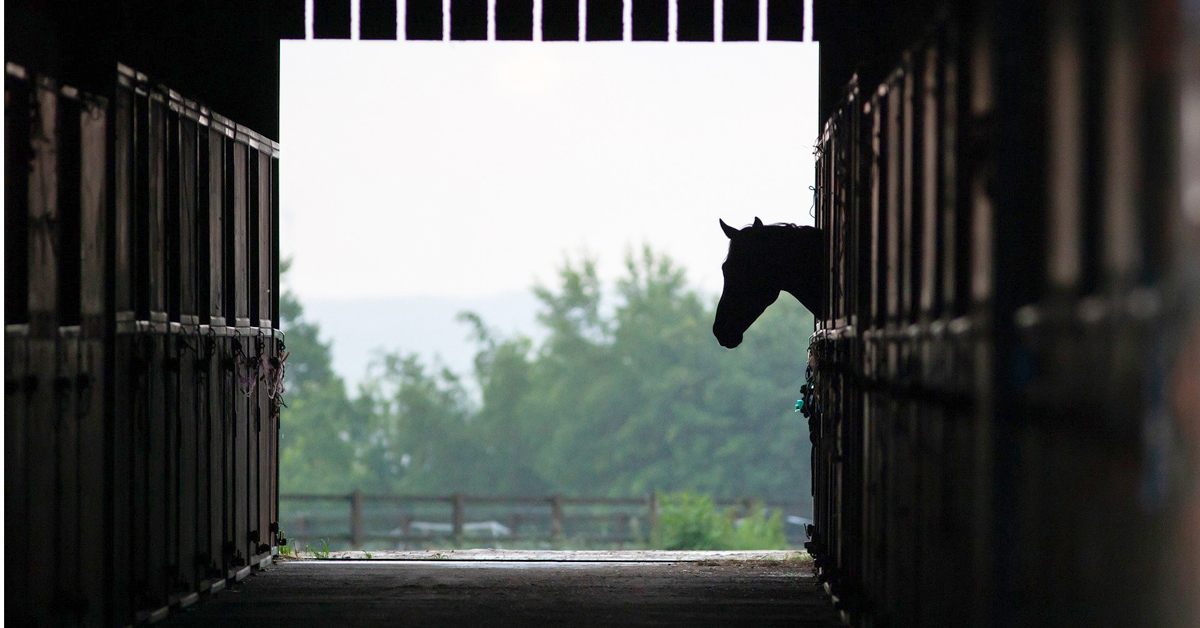As I spend another day in COVID lockdown I am overwhelmed by conflicting emotions, none of them good: frustration, anger, hopelessness, loneliness, grief, powerlessness …
Although restrictions are easing, we have all now lived through not being able to see our friends and family outside of our immediate bubble. We can talk to them through imperfect technology, but we cannot touch them, and we must maintain our two-metre distance.
As I resign myself to the ‘new normal’ pain of physical distancing, I am struck by what it feels like to be a modern sport horse. Equine physical distancing is the established industry norm. Horses are housed in individual stalls (and paddocks for the lucky ones); they can usually see their friends, but they cannot touch them, thanks to floor-to-ceiling stall walls and paddocks separated by electric wire.
Sadly, this enforced physical distancing is equally stressful for horses as it is for humans. When given the opportunity for a natural organization, horses operate within a complex social system. They form attachments, show preferences for particular herd mates, experience distress when separated, and even grieve their loss. Although we cannot interview horses about their attachment relationships, we can only presume that they need this horse-to-horse contact as much as humans need humans. In a sense, COVID-19 has forced us all into an extraordinary and excruciating experiment to live as our sport horses do.
In a landmark study, Visser and colleagues (2008) explored the effects of individual stabling vs. pair-shared stabling on 36 Warmblood two-year-olds being stabled for the first time. In spite of a 12-week confinement (only 20 minutes per day on a treadmill), the youngsters sharing a stall exhibited few physiological or behavioural stress indicators. In stark contrast, the unfortunate individually-housed teenagers demonstrated many stress responses –whinnying, frequent defecating, pawing, and chewing on the stable doors. Alarmingly, 67% of the individually-housed horses developed serious stereotypies (weaving, stall walking, and cribbing), whereas none appeared in the pair-housed youngsters, suggesting that it is isolation, more than confinement, that is the acute stressor in our modern management systems.
The research has been robust. Compared to group or pair-housed, horses housed individually demonstrate higher rates of stereotypies (e.g. Sarrafchi et al, 2013), exhibit more stress related behaviours, and physiological measures of stress (Visser et al., 2008), are more difficult to handle (Yarnell et al., 2015), or, alternatively, exhibit apathy, depression, and a state of learned helplessness (Furieux et al., 2012).
Katherine Reid’s New Zealand group found that social isolation may be perceived by horses as a greater threat than pain. When socially isolated horses were exposed to mild physical pain (the skin of the horse’s neck was pinched with a clamp), horses were restless, whinnying, searching for human contact, and their heart-rate was elevated. Horses experiencing the skin pinch with a buddy nearby exhibited few stress-related behaviours and no heart rate changes. The authors note that the typical pain response was overridden by the anxiety of social isolation, and that we need to consider this stressor when evaluating equine welfare.
Also, like us, being social is what horses choose. Anja Zollinger of the Swiss National Stud offered breeding stallions a choice between “social bars” between stalls (that allow nose touching only) or “social stalls” (where horses could pass the head, neck, and legs into the adjacent stall). Stallions overwhelmingly choose the latter. Injuries were minor and caused by the bars rather than from other horses, and nearly all the interactions were affectionate or playful.

Horses crave companionship and operate within a complex social system, forming attachments with certain herd mates. (Jean Alves/Pexels photo)
Ironically, the one purported advantage of individual stabling – that it keeps horses safe – is not borne out in recent research. Contrary to popular wisdom, individually housed horses sustain more injuries in their lower limbs (Sanmartín Sánchez, et al. 2020), show higher incidence of lameness (Giupana et al., 2017), and sustain greater incidents of tendon, joint, and health problems (Popescu et al., 2019) than do group-housed horses.
Yet, the majority of our individually housed horses don’t appear to be suffering. I would suggest that horses’ suffering is not obvious and we are poor detectives. It makes good evolutionary sense for horses, as prey animals, not to advertise their pain, so their “stoicism” may be real and adaptive.
Even when behavioural signs of suffering are overt, we often miss it. French researchers Lesimple and Hauseberger (2014) found huge discrepancies between caretakers reports of the occurrence of stereotypies in the horses under their care (5%) and researchers’ observations of these same horses (37%). Furthermore, the higher the rate of stereotypies at the stable, the less likely the caretakers were to see it, suggesting that continued exposure to many suffering individuals distorts caretakers’ perceptions of “normal.”
Perhaps the COVID lockdown can be our wake-up call, having experienced social isolation first-hand, to be our horses’ advocates, challenge the industry norm, and explore alternatives to let our horses interact. We need to allow horses to be the social beings that they are – the same social nature that gives us free access to their soul, and replenishes our own.

